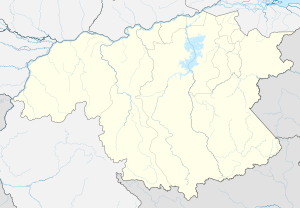Guri reservoir
| Guri reservoir | |||||
|---|---|---|---|---|---|
| The dam of the power plant | |||||
|
|||||
|
|
|||||
| Coordinates | 7 ° 46 ′ 0 ″ N , 63 ° 0 ′ 0 ″ W | ||||
| Data on the structure | |||||
| Construction time: | 1963-1986 | ||||
| Height above foundation level : | 162 m | ||||
| Building volume: | 77.971 million m³ | ||||
| Crown length: | 7500 or 11,409 m | ||||
| Power plant output: | 8,850 MW | ||||
| Data on the reservoir | |||||
| Altitude (at congestion destination ) | 272 m | ||||
| Water surface | 4250 km² | ||||
| Reservoir length | 175 km | ||||
| Reservoir width | 48 km | ||||
| Storage space | 138,000 million m³ | ||||
| Design flood : | 25,500 m³ / s | ||||
The Guri Reservoir (Spanish: Represa Raúl Leoni de Guri or Embalse de Guri ) is a 4,250 km² reservoir in the Venezuelan state of Bolívar .
It was created by the construction of the dam of Guri, whose dam about 130 km southeast of Ciudad Bolívar and 90 km southwest of Ciudad Guayana is located and the river Río Caroní about 90 km above its confluence with the Orinoco dams. In addition to generating electricity, the dam is also used for flood protection .
Reservoir
The reservoir is approx. 130 km long and up to approx. 70 km wide; its depth is at maximum 170 m, on average 30 m. With its surface of 4,250 km 2 and its volume of 138 km³, it is one of the largest reservoirs on earth .
The lake is full of fish and therefore a paradise for sports anglers who mainly the Pavón fish, a cichlid from the genus Cichla . There are also many other uses for recreational activities.
Buildings
From 1963 to 1969 a 106 m high and 690 m long earth and rock embankment was built, with which a storage target of 215 m above sea level was realized. The associated hydropower plant had an installed capacity of 1,750 MW. After an increase in output, the value in 1978 was just over 2 GW, provided by ten turbine units.
In order to meet the increased demand for energy, in a second construction phase from 1976 the dam was extended to 7,426 m (11,409 m according to other information) and raised to 162 m. This enlarged the lake and reached a storage target of 272 meters above sea level. During the construction work, part of the dam was provided with a 1.3 km long concrete gravity dam and a second relief channel was created. In addition, a second nacelle was built in which a further ten turbines with an output of 630 MW each were installed.
There are three flood reliefs that are particularly necessary in the rainy season from May to October in order to discharge the enormous inflowing water quantities of up to 25,500 m³ / s.
Power generation
With an output of up to 8.85 GW and an annual production of around 40 TWh of electricity, the power plant on Guri-Damm is one of the largest hydropower plants in the world . In purely mathematical terms, it alone covers more than a third of national electricity consumption. In fact, however, part of the electricity generated is exported to Colombia and Brazil .
In March 2019, the reservoir hit the international headlines due to a four-day blackout in Venezuela. The reason given was the network congestion and the unprofessional administration; not only had the technicians left Corpelec and the country in large numbers, the leadership had also been replaced by loyalists. Technicians who had already warned of such a blackout in May 2018 had been arrested. Even before the blackout, only 11 of the 20 turbines were still in operation. According to statements by employees, maintenance work had been behind schedule for years and the frequent partial power failures, which were already widespread, put a heavy load on the technical installations. Only the second plant, Guri II, was extensively renovated in 2012 by Andritz . Of the thermoelectric systems from the state company Corpoelec , which were purchased between 2004 and 2014 and should have supported the network, 50 percent were inoperable.
Names
The hydroelectric power station got its current name Central Hidroeléctrica Simón Bolívar in 2006 due to a decree by President Hugo Chávez . From 1974 to 2006 the power plant was named Central Hidroeléctrica Raúl Leoni , after the former Venezuelan president.
- Guri hydroelectric power station
Machine transformer on the power plant site
See also
- List of the largest dams on earth
- List of the largest reservoirs on earth
- List of the largest hydroelectric plants in the world
- List of power plants in Venezuela
- List of dams in the world (Venezuela)
Web links
Notes and individual references
- ↑ Database for Hydrological Time Series of Inland Waters (DAHITI) - Guri, Lake , accessed April 20, 2017.
- ^ A b CVG Electrificación Del Caroní, CA: Cifras 2006 , ISSN 1315-2386 . Caracas, Agosto 2007, p. 14.
- ↑ a b Encyclopædia Britannica Online . Encyclopædia Britannica, Inc. 2011. Retrieved March 23, 2013
- ↑ a b c d CVG Electrificación Del Caroní, CA: Cifras 2006 , ISSN 1315-2386 . Caracas, Agosto 2007, p. 12.
- ↑ Venezuela blackout: what caused it and what happens next? , The Guardian, March 13, 2019
- ↑ a b The dropouts and corruption are driving the collapse of the Venezuelan electricity system , El Pais, March 9, 2019
- ↑ Why Venezuela Remains with No Power: FAQ , caracaschronicles.com, March 11, 2019




